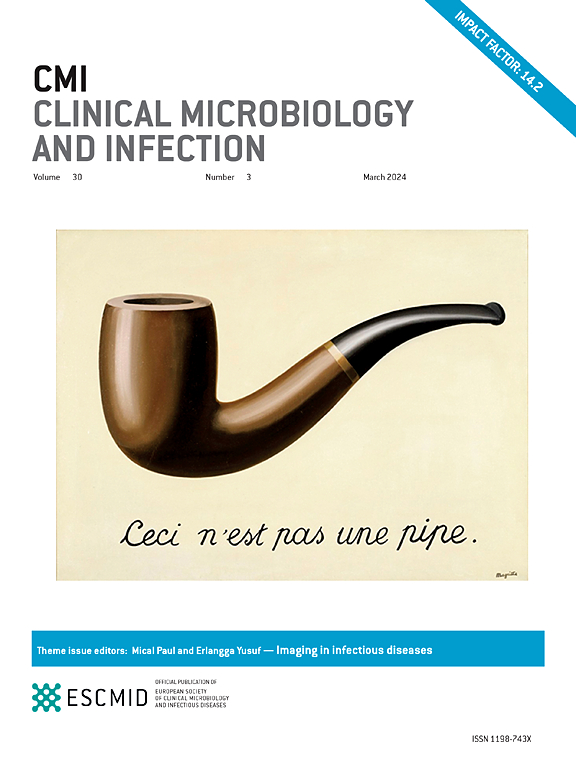通过 EUCAST 和 CLSI 肉汤微量稀释及梯度扩散条进行的念珠菌 MIC 检测;对两性霉素 B 是否耐药?
IF 10.9
1区 医学
Q1 INFECTIOUS DISEASES
引用次数: 0
摘要
目的:据报道,白色念珠菌对两性霉素 B 的耐药率差异很大。这可能反映了与临床相关的药敏性差异、检测技术问题或采用了将野生型群体一分为二的临床断点(BP)。我们使用共享的 C. auris 菌株库比较了参考方法和两种梯度扩散条:方法:纳入了来自美国九个州、≥3 个支系的 40 株 C. auris 菌株。使用 EUCAST E.Def 7.4、CLSI M27Ed4、Etest 和 MTS(Liofilchem)条带 MIC 生成 14 个 MIC 数据集。MIC≤1 mg/L 被归类为易感:结果:EUCAST和CLSI两性霉素B的MIC测试在各种方法变量中都很稳健。模态 MIC 为 1 毫克/升,呈单峰分布,范围较窄,GM-MIC 相似(0.745-1.072);但药敏性分类各不相同(0-28% 抗药)。梯度扩散带测试结果显示,8/9 个数据集的分布较宽且呈双峰分布。如果按照制造商的协议,在 Etest 方法中采用双重接种,则模态 MIC 增加到 2-4 mg/L,耐药率增加到 45-63%,而单次接种的耐药率为 25-30%。EUCAST、CLSI、Etest和MTS条带的MIC与无药对照EUCAST孔的OD相关,表明一些分离物比其他分离物生长得更好,这与MIC有关:结论:EUCAST 和 CLSI 的 MIC 结果接近一致,而条带测试则显示出更广泛的双峰分布,读者与读者之间以及中心与中心之间存在差异。我们的研究增加了人们对两性霉素 B 抗球虫商业 MIC 检测的担忧,并表明目前的断点会导致随机药敏性分类。本文章由计算机程序翻译,如有差异,请以英文原文为准。
Candida auris MIC testing by EUCAST and clinical and laboratory standards institute broth microdilution, and gradient diffusion strips; to be or not to be amphotericin B resistant?
Objectives
Reported amphotericin B resistance rates for Candida auris vary considerably. This may reflect clinically relevant differences in susceptibility, technical issues with testing, or adoption of a clinical breakpoint that bisects the wild-type population. We compared reference methods and two gradient diffusion strips using a shared C. auris strain collection.
Methods
Forty C. auris strains from nine U.S. states and ≥3 clades were included. Fourteen MIC data sets were generated using European Committee on Antimicrobial Susceptibility Testing (EUCAST) E.Def 7.4, Clinical and Laboratory Standards Institute (CLSI) M27Ed4, Etest, and MIC gradient test strip (MTS, Liofilchem) MICs. MICs ≤1 mg/L were classified as susceptible.
Results
EUCAST and CLSI amphotericin B MIC testing were robust across the included method variables. The modal MIC was 1 mg/L, distributions unimodal and narrow with similar geometric mean (GM)-MICs (0.745–1.072); however, susceptibility classification varied (0–28% resistance). Gradient diffusion strip testing resulted in wider and bimodal distributions for 8/9 data sets. If adopting, per manufacturer's protocol, double inoculation for the Etest method, the modal MIC increased to 2–4 mg/L and resistance rates to 45–63% versus 25–30% with the single inoculation. The EUCAST, CLSI, Etest, and MTS strip MICs correlated to the optical density of drug-free control EUCAST wells, suggesting that some isolates grew better than others and that this was associated with MIC.
Discussion
: The EUCAST and CLSI MIC results were in close agreement, whereas the strip test showed wider and bimodal distributions with reader to reader and centre to centre variation. Our study adds to the concern for commercial MIC testing of amphotericin B against C. auris and suggests the current breakpoint leads to random susceptibility classification.
求助全文
通过发布文献求助,成功后即可免费获取论文全文。
去求助
来源期刊
CiteScore
25.30
自引率
2.10%
发文量
441
审稿时长
2-4 weeks
期刊介绍:
Clinical Microbiology and Infection (CMI) is a monthly journal published by the European Society of Clinical Microbiology and Infectious Diseases. It focuses on peer-reviewed papers covering basic and applied research in microbiology, infectious diseases, virology, parasitology, immunology, and epidemiology as they relate to therapy and diagnostics.

 求助内容:
求助内容: 应助结果提醒方式:
应助结果提醒方式:


